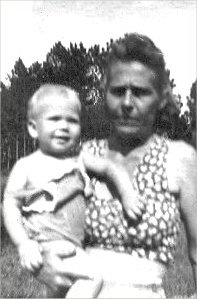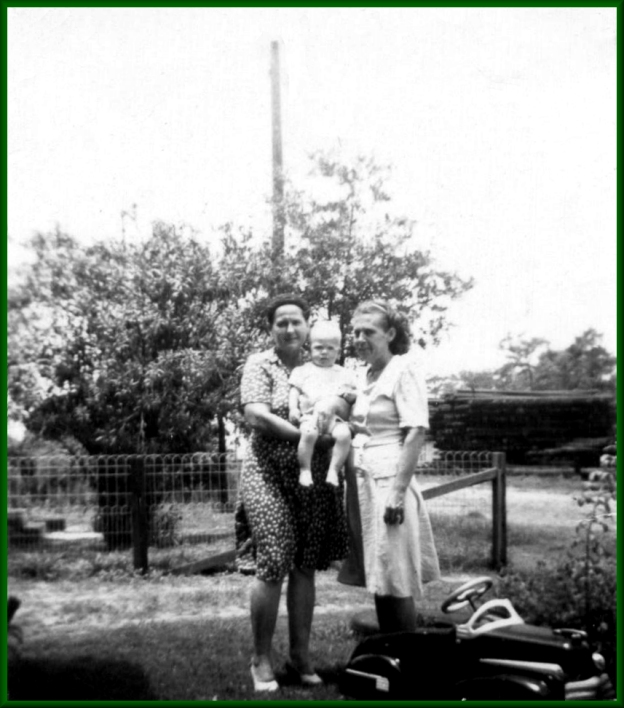 
I was born in 1946. At the time, my parents were living closer in to Jacksonville on 23rd Street which which comes off of Talleyrand Avenue. This is near the center of town on the northwest side of the St. John's River at what is known as the Talleyrand Docks. It was just after the the Second World War. Jacksonville was not yet the major military seaport that it is today; but, there was a lot of shipping activity here, some of it related to the war. My brother was in the army at the time somewhere in the Philippines. My two sisters, one still in her teens, the other barely out, were still at home. Then I came along, fifteen years after my youngest sister, and quite a surprise to everyone!
Later that day, the Homestead, a gasoline tanker, was struck by lightning
while unloading aviation fuel at the Standard Oil Terminal on Talleyrand Avenue.
The fire spread to a nearby
ammunition ship - setting off explosions which rocked the entire
Talleyrand area for days. Three men were killed as Jacksonville Firefighters spent eight days fighting the blaze. My mother would often remember that time; and she always insisted that the ground shook for three weeks! She also remembered, with sorrow, the many cats that had been aboard the ships. They managed to escape the explosion and fire; but, all but one later died of all the oil they had ingested while swimming through the oily waters to get away from the burning ships. My mother and her brother, Nelson, who also lived in the Talleyrand area, tried to save them but they were pretty much alone in it. Back then most people were just not that concerned about animals. The cat that did survive was taken in by Nelson who named her "Miss Chick." She had one litter of kittens before my uncle had her spayed, a somewhat unusual thing to do back then when animals were generally just allowed to breed come what may. My uncle also kept all the kittens and had all of them spayed or neutered. "Miss Chick" and her son, "Toby," both lived to be over 20 years old. I remember them well - big, fat black and white cats! Some six months after the explosion, my father decided to move. He bought some land way out at what back then wasn't even Jacksonville but just northern Duval County. It was on Lem Turner Road across a fat, lazy tributary of the St. John's River which is known as Trout River. To some people in Jacksonville, "the Northside" is simply that part of Jacksonville which is north of the St. John's River. To purists like myself, however, the Northside is the area north of Trout River and that is how I am using the term. My northside consists of four major communities Garden City, Highlands, Oceanway, and Dinsmore.  On this website, at least for now, I will mostly be writing about Garden City since that is where I grew up. There is a WalMart there now and a shopping center; but, back then it was all pretty unsettled territory. At least it seemed unsettled. In fact, there had been a community of sorts there for many years. Old settlers, they are called; and, I wouldn't say they are exactly clannish but they know who they are! My family has been here for over fifty years and to some of the newer people that makes us old settlers; but, the real old settlers know better. We are merely long time residents. Anyway, by this time, it was 1947 and my brother was no longer in the army; so he helped my father build the house. Back then, you didn't have to have a building permit or anything. If you wanted to build, you just started to build; and, you built it whatever way you could with whatever you could lay your hands on. My father worked at a creosote plant. So he build much of the house with lumber preserved in creosote, just about the entire foundation, in fact. I still vividly remember the naked ties and beams of that house. He never did get around to covering them over with sheet rock walls or anything like that. The house was a "work in progress" that was never finished.  The picture above is an early picture of the old house. I am supposed to be there on the porch; but, to be honest, I don't see me; but, I do see my mother and father. If you look real close you can see two big concrete urns, one of each side of the porch steps. My mother used to grow a succulent called "hen and biddies" in those urns. Later on my father planted three gardenia bushes right in front, in a row, about one third the distance from the house to the barbed wire fence. Back then most fences were barbed wire. There were no "chain link" fences. The gardenia bushes got to be pretty good size before we finally left Lem Turner Road. They don't show in the picture; but, to the right, just on the other side of the driveway there were some crape myrtles. Back then all crape myrtles were bright pink. There were no pale pinks, or lavenders, or white crape myrtles like there are today. I remember those crape myrtles because one day I decided to climb one and ran into a nest of yellow jackets! In the back, there was quite a bit of land and even an outside toilet. I don't remember when we first got running water in the house; but, I know it was quite a while before we had a flush toilet. The city water line did not run out that far; so my father had to dig a well and put in a septic tank and things like that do take time. My mother had an old wringer type washing machine on the back porch. That is what back porches were used for back then, old messy wringer washing machines!
I would help my mother do the laundry. After the clothes were washed, she would take them out, one by one, and put them through the wringer; and, I would catch them on the other side and put them in a washtub. Then we would repeat the whole process for a rinse; and, she would take them out to the clothesline and hang them up. I always caught the clothes and put them in the washtub. My mother would never let me put the put the clothes through the wringer. She was afraid I might catch my fingers. Out back we had a big garden. I especially remember the sweet potatoes and how dirty I would get helping my father dig for them. We had lots of animals too. |
 My
mother had to "have
her pains started." I guess they would call it
My
mother had to "have
her pains started." I guess they would call it


